In the Premier League season’s first “superderby”, as it was reckoned all over the globe, Liverpool welcomed Manchester City in what was from the start of the competition planned to be the battle for the trophy. The two teams are clearly the most serious contenders for the first place at the end of the season, and this duel brought one of them closer to the final goal.
Jürgen Klopp’s tactics were good enough to secure a win for his side and to make the visitors struggle at Anfield, even though they also missed out on luck when it comes to the final 3-1 result for the home team. This tactical analysis will show you how the Reds manage to get away with the very important triumph and how they created a bigger point gap between them and their biggest competitors.
Lineups
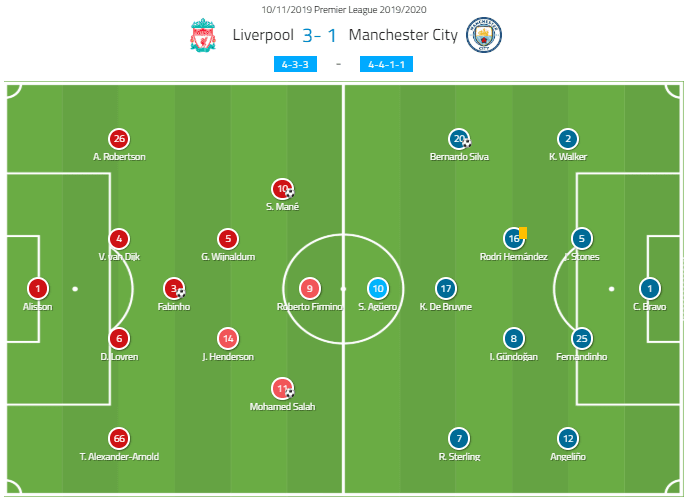
The host coach went into the game with his usual 4-3-3 tactics and with no surprises in the starting eleven. As Joel Matip wasn’t fit to play in this fixture, Dejan Lovren filled in his shoes and played alongside Virgil van Dijk in the centre of their defence. Fabinho was the man in control of the midfield, together with Georginio Wijnaldum and Jordan Henderson who provided him with help. Their deadly trio – Mohamed Salah, Roberto Firmino and Sadio Mané – was once again playing up front, and was the key threat for Claudio Bravo’s goal.
Pep Guardiola set his team in the 4-2-3-1 formation which was slightly different from what we were used to seeing from them. He decided to go in with the double pivot embodied in İlkay Gündoğan and Rodri, while Kevin de Bruyne was playing as a number ten. Bernardo Silva on the right-hand side with Raheem Sterling on the opposite were the two wingers, and Sergio Agüero was the link-up striker.
Closing down City’s progress
Liverpool started the match with a decisive but careful attitude and tried to allow their opponent to have the possession and rely on good transitive attacks which gave them a two-goal advantage in the opening phase of the duel. As they developed their play under Klopp, the out-of-possession play became their biggest strength because of their discipline and good defensive organisation.
They continued with that style of play in this derby whilst also trying to press from the central zone and to disable easy through-line progress for Pep’s men. The key to their success was good marking when Manchester City’s actions were in the beginning stages. They did a great job closing down the passing lanes to Gündoğan and Rodri who were planned to transfer the ball from defence to offence while pressing the defenders at the same time.
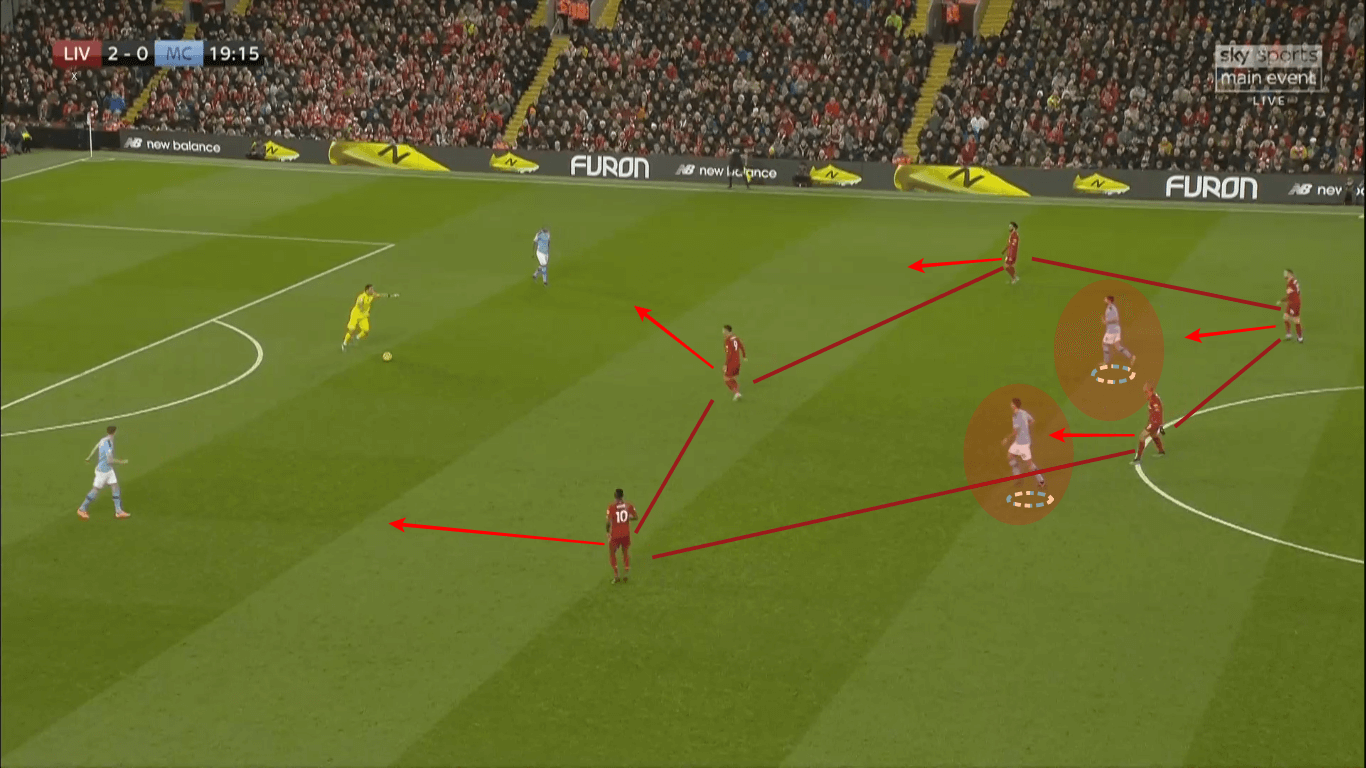
As we can see, the two defensive midfielders were locked in difficult positions and were quite exposed to be pressed if passes got addressed to them in this zone. Fabinho was in constant movement and was always close to the action, helping his attackers organise high pressing and win the ball in the dangerous areas.
If the pressure in the opponent’s half of the pitch wasn’t successful, Liverpool would drop lower and set themselves up in the tightly drilled defensive block with clear intentions of closing down the key creative players of the opposition. They did that by “caging” them in the same manner as they did against the defensive midfielders in the higher zones of the pitch.
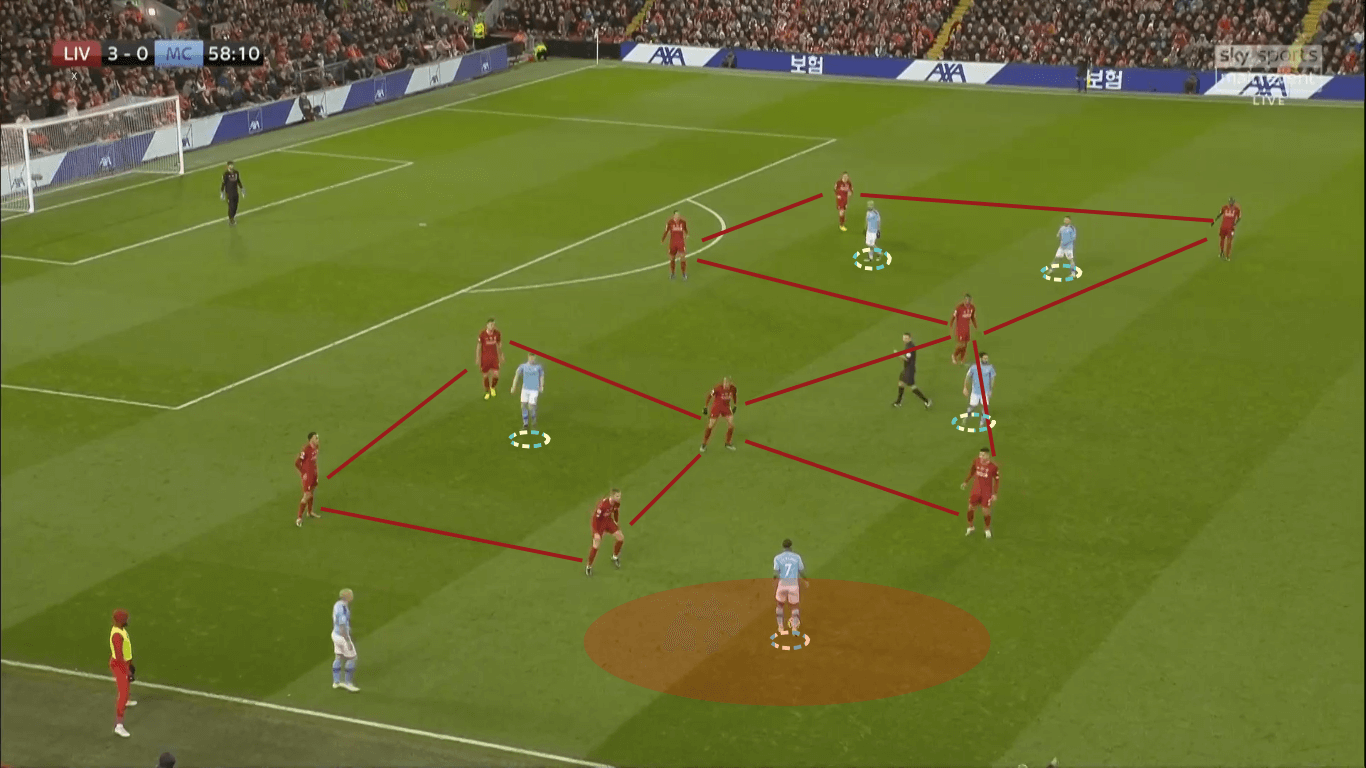
In the picture above, it shows how the Reds’ defence was oriented into numerically overpowering Man City’s forwards and attacking mids. De Bruyne and Silva, as the main “minds” of Guardiola’s side, were guarded with a huge focus and left with a very small place to manoeuvre, while the far options were locked in the 4 v 2 situations. Also, they tried to force Sterling further from the final third so he couldn’t participate in the deciding moments of attacks, which resulted in him getting a lot of balls pretty close to the sideline.
The expected De Bruyne, Sterling and Silva’s runs from the edge of the box into the inner-corridor gaps were closed with good movement and switching from the Liverpool defenders. They were very quick in communication and they defended the away team’s key run-in weapon which made it easier for them to protect their goal.
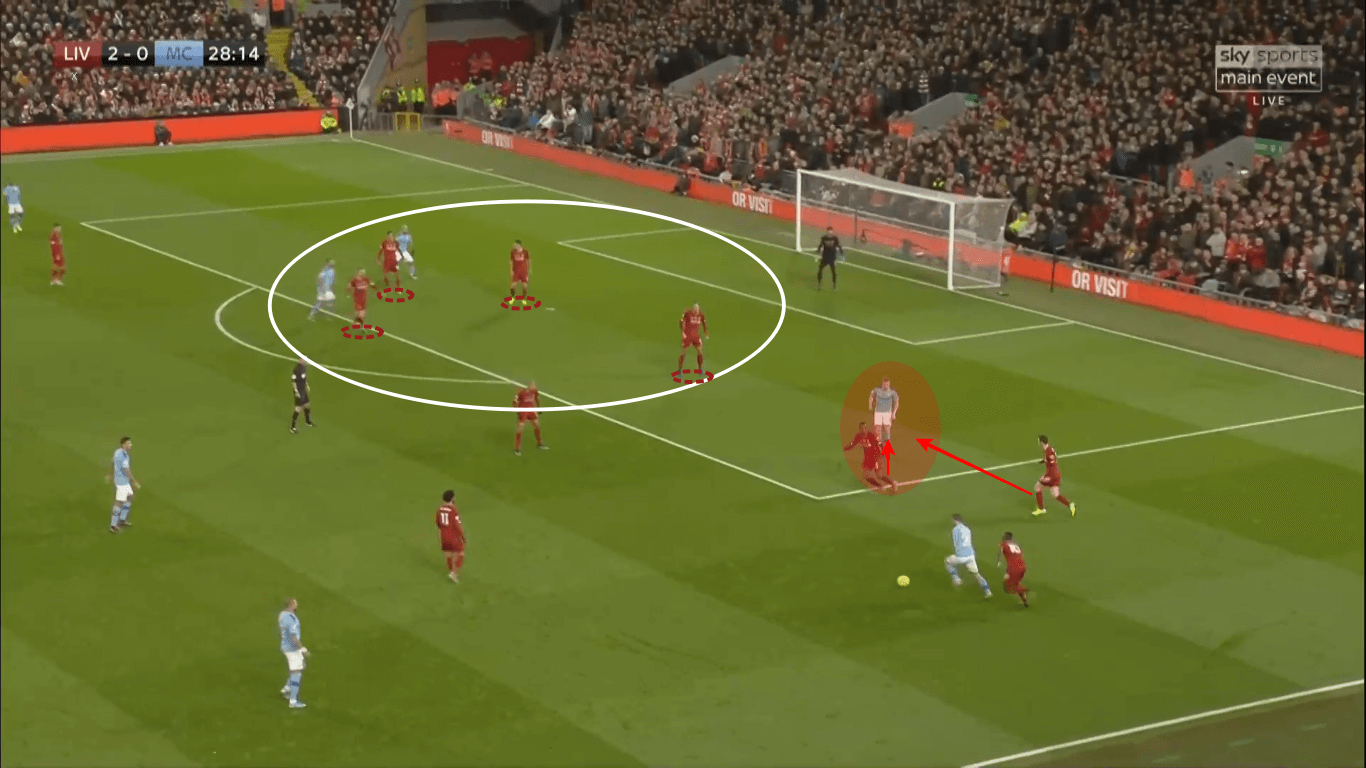
While the Belgian was neutralised and the wingers were shut down at the flanks, City was forced to try to endanger the hosts with crosses and in-box passes. Good motions and cooperation of Klopp’s team’s defensive line enabled them to deal with threats with no bigger problems as they often created a lot of surplus situations over the attackers.
The visitors also had difficulties with progressive play, as the midfielders of their opposition did a good work roaming over the field and closing down passing lanes along with double or triple-teaming direct rivals.
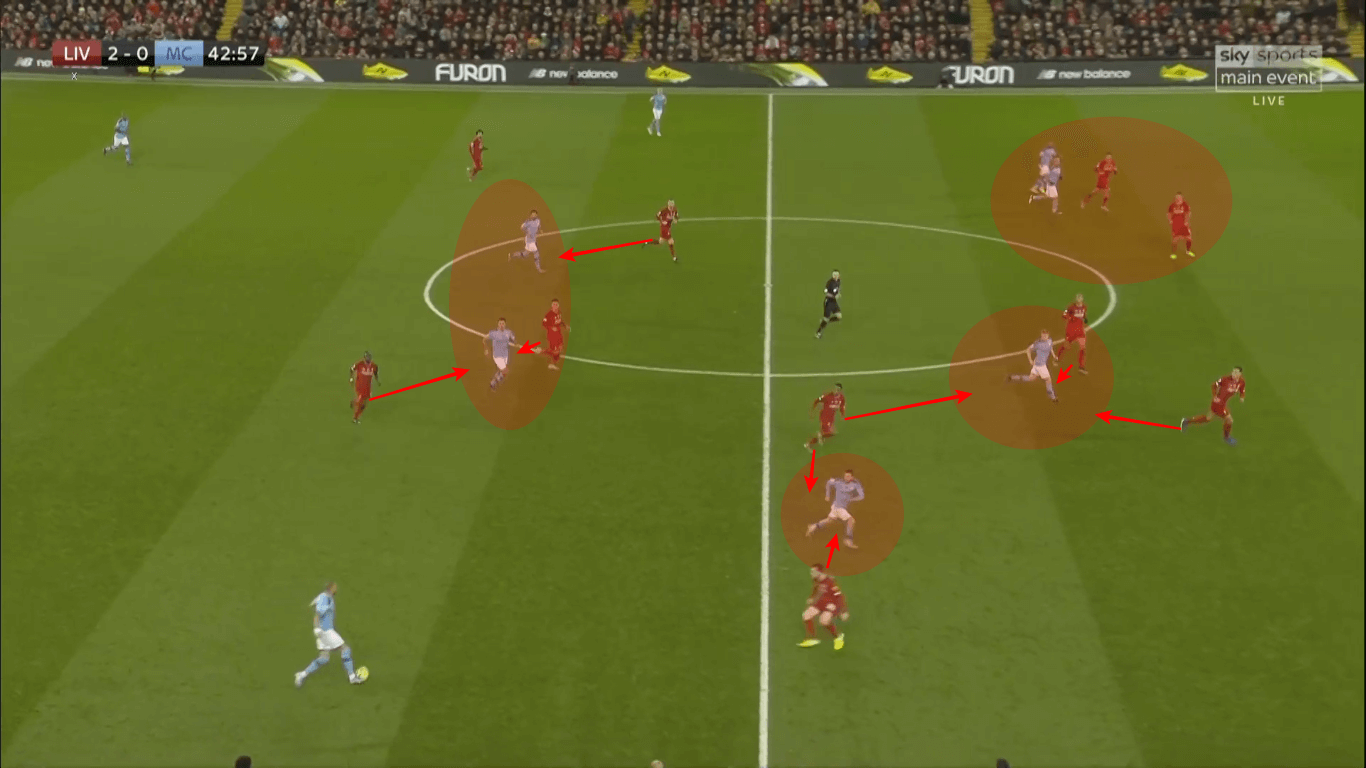
Fabinho once again was the key man in orienting the defence and guarding the main pass-forward options of Pep’s side. Their wingers also often dropped lower to help their full-backs which led Manchester City into having very few options to play progressively.
Liverpool’s transition
Out of the tight and disciplined defence, Klopp’s team tended to play fast and direct football that relied on rapid transformations. The visitors went into the match with an attacking approach, trying to hide their defensive weaknesses with the possessional play, living on the grounds of the parole that “offence is the best defence”.
When Man City went higher up the pitch, the space behind them broke open and was good to be exploited by the Reds’ attackers who had a pace advantage over their rivals. They often had numerical superiority over the high positioned defence which lead them into good goal-scoring chances, or even into scoring.
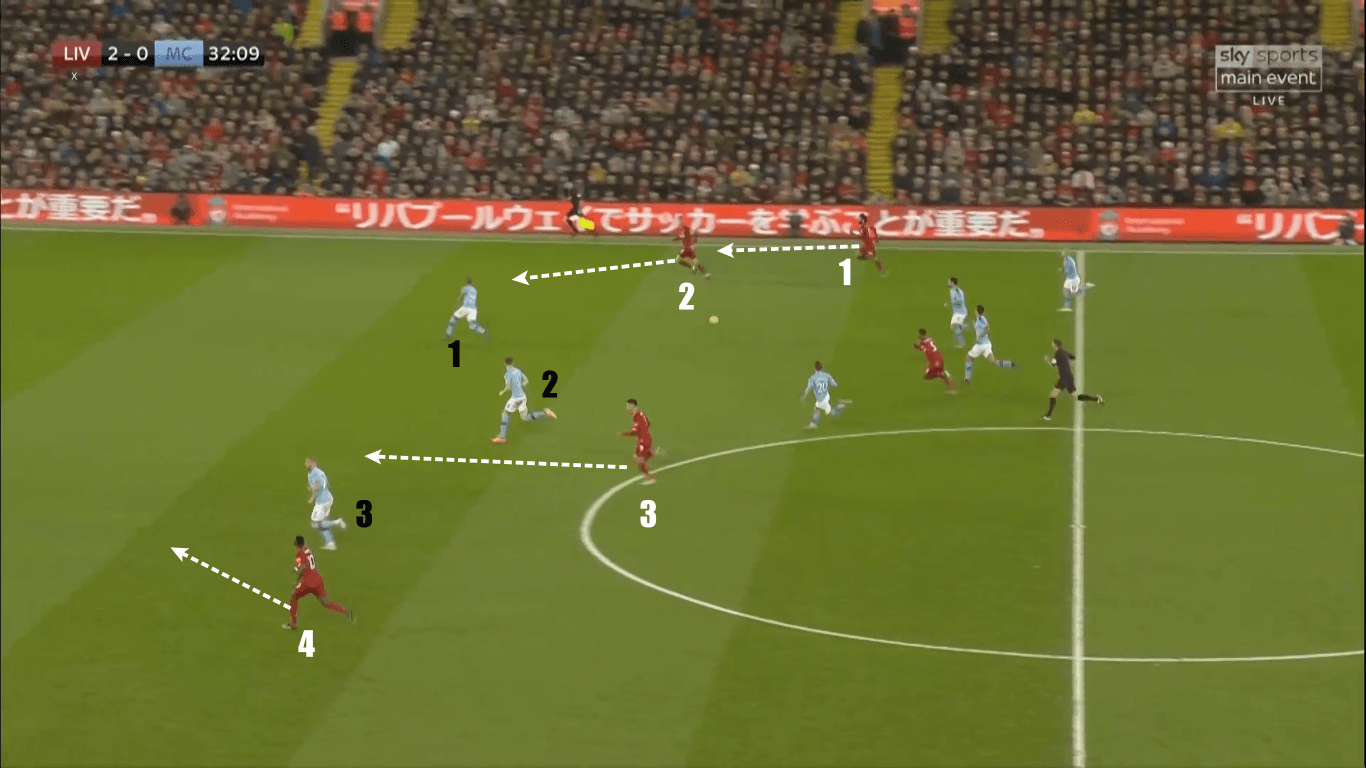
In the image above, we can see how Liverpool performed their transitional actions. Salah, Mané, and Firmino were the ones leading the front and were provided with help from the full-backs, as well as Henderson and/or Wijnaldum who tracked the play pretty well. The situations as the one overhead repeated constantly with the clear intention from the hosts to exploit Fernandinho at the centre-back position.
The home team sensed they had a physical advantage over the opposition’s defence and started getting the better of them mostly with transitions. Those attacks were usually taking place at the flanks, where wide player duos had a speed superiority against them in the wider rooms.
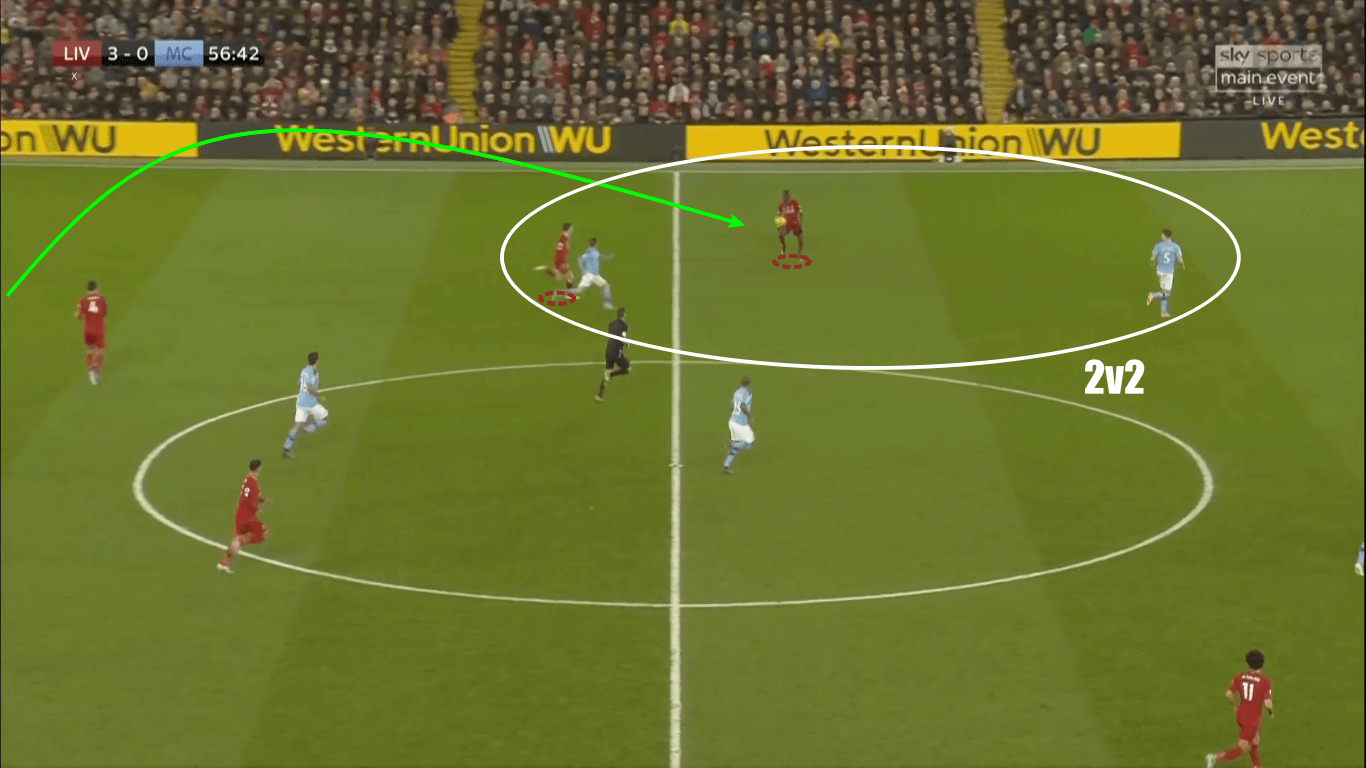
The team from Anfield tried to get their players in the 2 v 2 situations against opponent’s centre-back and full-back tandem as often as possible, and that was very lucrative for them because of their agility and fast legs which Stones and Fernandinho especially couldn’t follow.
Firmino opened an extra option for Liverpool’s transition. As always, his movement was on a high level and he time and again found gaps in not-that-organised Manchester City’s defence. He lowered himself in the space between the lines and gave his teammates a progressive pas-through solution.
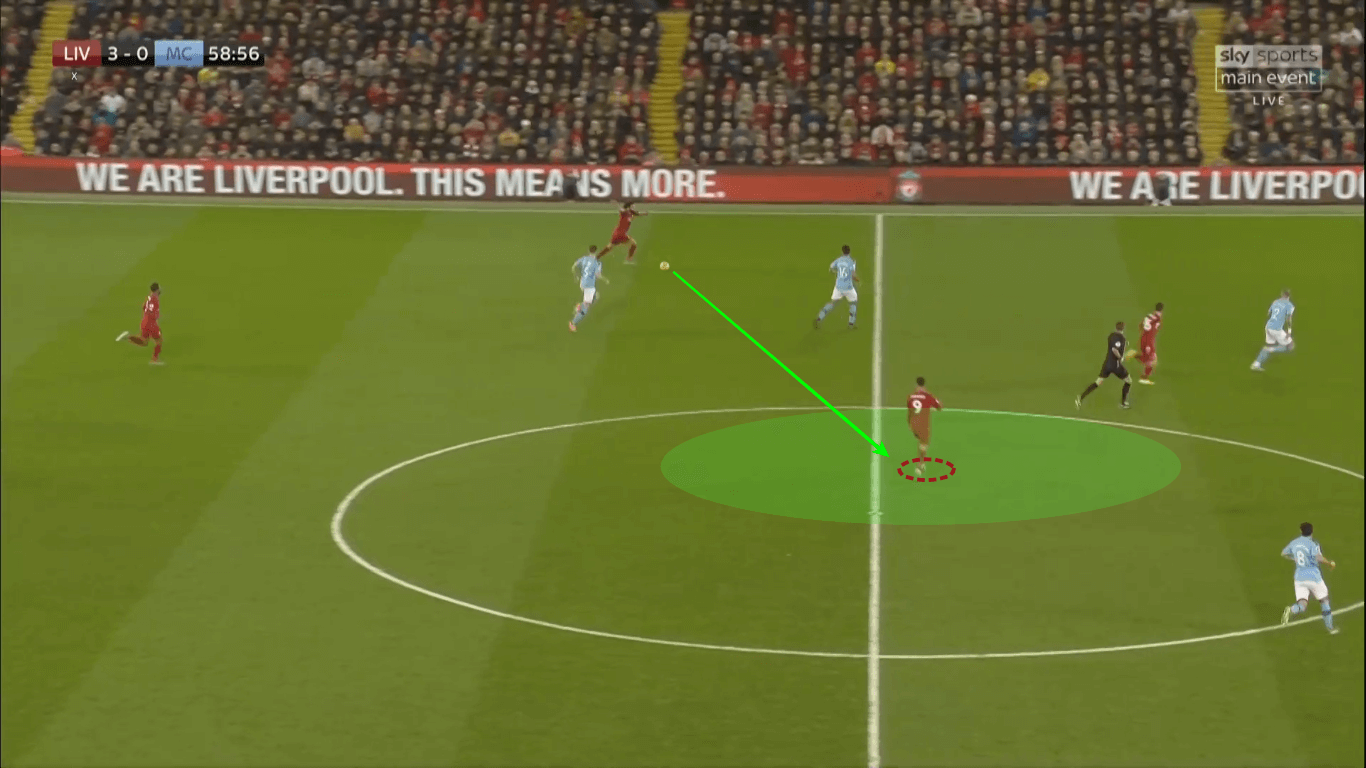
His positioning enabled them to switch sides of the action fast and to play it more directly, which was of huge importance for them because their most dangerous chances came out from those situations.
Skipping the midfield and playing it diagonal
As we said, the key to beating Guardiola’s side in this match was to exploit their vulnerability in the defensive line, which was interwoven with the lack of matches together along with the pace disadvantage. The home team decided to get the use of that by playing it with long balls and trying to skip the action quickly to the other flank.
There were plenty of long diagonal passes that were a result of the above-mentioned idea. The main target of those balls was Mo Salah, as he had Angeliño against himself as the direct guard, who clearly wasn’t on the Egyptian’s level. After those actions took place, Henderson went higher almost all the time to provide his winger with help and to construct a 2 v 1 situation against the defender in the wide area of the pitch.
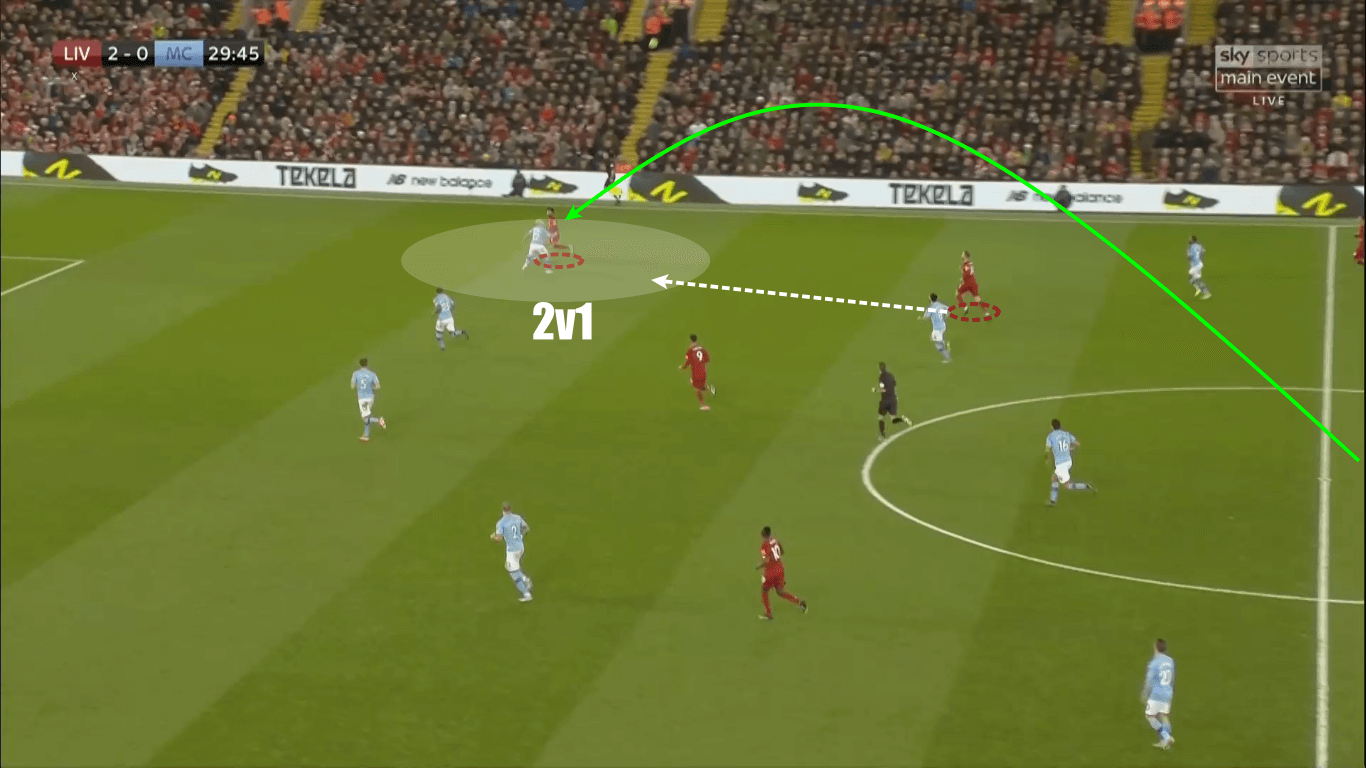
As we can see, Liverpool’s captain moved high up the pitch and often repeated supportive runs into the right half-space. Those actions disrupted the organisation of City’s defence and broke their lines which made it easier for the hosts to get to their chances. The wide positioning of Henderson was Klopp’s idea to play it in a more forward manner, as both he and Wijnaldum oftentimes pulled themselves to the flanks to open up progressive options for their lower teammates.
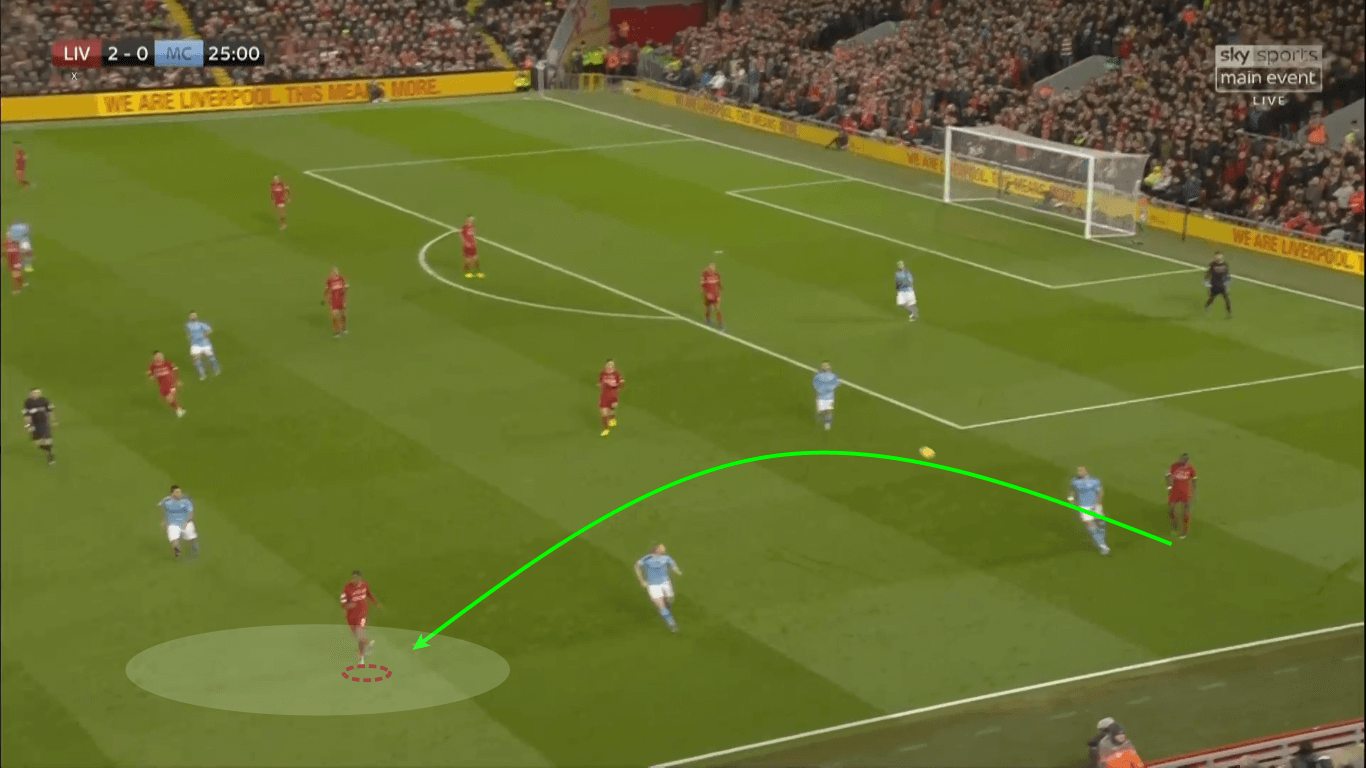
The two midfielders frequently operated next to the sidelines and tried to get the ball out wide. The reasons for doing so was to drag the wide defender higher and leave non-guarded space in the higher flank-areas for their attack, and also to create a bigger gap between unsure centre-backs and full-backs of Man City’s lineup.
As much both Wijnaldum and Henderson reprised those wide motions, they did them in different areas of the pitch. The Dutchman mostly played as a pass-forward option at the beginning of the attacks and as a press-breaking player, while the England international’s role was more of a supportive one and took place in a higher zone closer to the opposition’s goal.
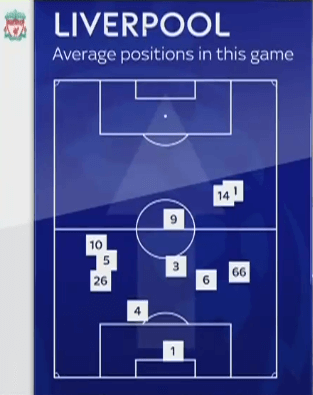
That can also be seen from the image above that shows the average positions of Liverpool’s players in this match. It is clear that the home team tried to play it on the left-hand side in the start of their build-up, while the attacking actions were reserved for the players playing down the right-handed sideline.
Long balls were one of the main weapons for Klopp’s men in this match and were often addressed next to Fernandinho who was pointed out as the weakest link in the air for the visitors. Firmino and others often came close to him so they could be targetted as the forward solutions, which was repeatedly successful for them.
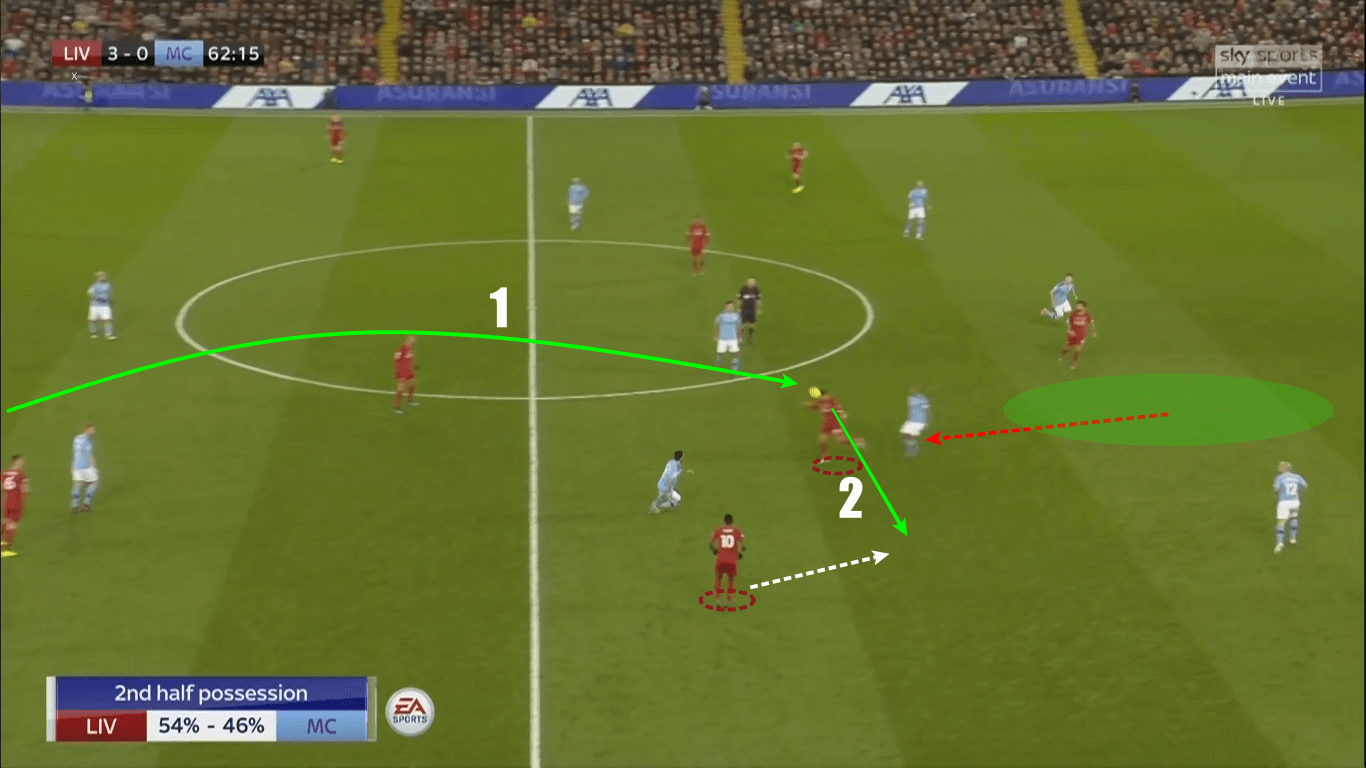
We can see the pattern of Liverpool’s long balls that were dangerous for Manchester City in two different ways: through the aerial advantage over Fernandinho, and because of the gap that opened behind his back after he went for the duel with the striker.
Conclusion
Liverpool exploited Man City’s defensive flaws. As it was shown in the analysis, they cut down their progressive options and called them higher in order to get the use of the space left behind them, and the visitors went for the bait. Even though Guardiola’s side didn’t play that bad and can be frustrated with the refereeing, the hosts managed to profit on the merit of their bad cooperation in the defence and, what needs to be said – poor quality of the defensive line.
Good out-of-possession movements won the game for Reds and brought them in a good position as the point gap between the two is now bigger as it counts to nine points exact and Pep’s side will surely have a difficult job to get back in the battle for the trophy.

If you love tactical analysis, then you’ll love the digital magazines from totalfootballanalysis.com – a guaranteed 100+ pages of pure tactical analysis covering topics from the Premier League, Serie A, La Liga, Bundesliga and many, many more. Buy your copy of the November issue for just ₤4.99 here





Comments